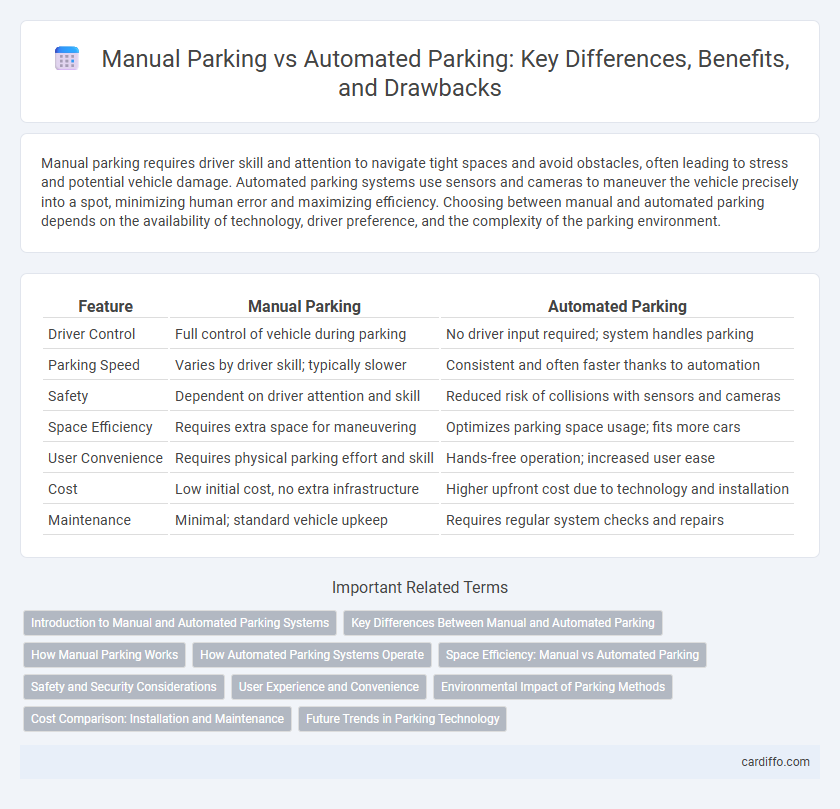Manual parking requires driver skill and attention to navigate tight spaces and avoid obstacles, often leading to stress and potential vehicle damage. Automated parking systems use sensors and cameras to maneuver the vehicle precisely into a spot, minimizing human error and maximizing efficiency. Choosing between manual and automated parking depends on the availability of technology, driver preference, and the complexity of the parking environment.
Table of Comparison
| Feature | Manual Parking | Automated Parking |
|---|---|---|
| Driver Control | Full control of vehicle during parking | No driver input required; system handles parking |
| Parking Speed | Varies by driver skill; typically slower | Consistent and often faster thanks to automation |
| Safety | Dependent on driver attention and skill | Reduced risk of collisions with sensors and cameras |
| Space Efficiency | Requires extra space for maneuvering | Optimizes parking space usage; fits more cars |
| User Convenience | Requires physical parking effort and skill | Hands-free operation; increased user ease |
| Cost | Low initial cost, no extra infrastructure | Higher upfront cost due to technology and installation |
| Maintenance | Minimal; standard vehicle upkeep | Requires regular system checks and repairs |
Introduction to Manual and Automated Parking Systems
Manual parking requires drivers to control vehicle positioning using steering, acceleration, and braking skills, relying on human judgment to navigate tight spaces and avoid obstacles. Automated parking systems use sensors, cameras, and advanced algorithms to autonomously steer, accelerate, and brake the vehicle into a parking spot with minimal or no driver input. These systems enhance convenience, reduce parking errors, and optimize space utilization in congested urban environments.
Key Differences Between Manual and Automated Parking
Manual parking requires driver skill for maneuvering into spaces, while automated parking uses sensors and software to park the vehicle independently. Automated parking systems reduce the risk of human error, optimize space usage, and can park in tighter spots than manual methods. Manual parking offers driver control and flexibility, but automated parking enhances convenience and safety in complex or crowded parking environments.
How Manual Parking Works
Manual parking requires the driver to control the vehicle's steering, acceleration, braking, and positioning to maneuver into a parking space. Drivers rely on visual judgment and spatial awareness to align the car within marked lines and avoid obstacles. This process involves multiple precise movements, often including steering adjustments and use of mirrors or backup cameras for accurate placement.
How Automated Parking Systems Operate
Automated parking systems utilize advanced sensors, cameras, and software algorithms to precisely navigate vehicles into designated parking spaces without human intervention. These systems rely on real-time data processing and machine learning techniques to detect obstacles, measure available space, and optimize parking maneuvers efficiently. By integrating components such as ultrasonic sensors, LiDAR technology, and robotic actuators, automated parking enhances safety, reduces parking time, and maximizes lot capacity.
Space Efficiency: Manual vs Automated Parking
Manual parking typically requires wider spaces to accommodate driver error and vehicle maneuvering, resulting in lower space efficiency. Automated parking systems utilize precise robotic technology to park vehicles in tighter, optimized layouts, significantly increasing the number of cars accommodated within the same footprint. This optimized spatial arrangement reduces the overall parking area needed, enhancing urban land use and lowering construction costs.
Safety and Security Considerations
Manual parking requires constant driver attention to avoid collisions, but offers full control over vehicle positioning in complex environments. Automated parking systems use advanced sensors and algorithms to reduce human error, enhancing safety by minimizing accidental impacts and improving precision. Security considerations favor automated parking in secure facilities, as remote monitoring and controlled access reduce the risk of vehicle theft or vandalism.
User Experience and Convenience
Manual parking demands precise driver skills and can cause stress in tight spaces, often leading to longer parking times and potential vehicle damage. Automated parking systems enhance user experience by simplifying the process, reducing the need for maneuvering, and saving time through sensor-guided, computer-controlled movements. These systems increase convenience by providing seamless entry and exit while optimizing space utilization in crowded parking facilities.
Environmental Impact of Parking Methods
Manual parking typically results in longer search times, increasing fuel consumption and CO2 emissions due to repeated vehicle movement. Automated parking systems optimize space utilization and reduce vehicle idling by guiding cars directly to available spots, significantly lowering greenhouse gas emissions. Implementing automated parking technology contributes to urban air quality improvement and reduces the carbon footprint associated with conventional parking methods.
Cost Comparison: Installation and Maintenance
Manual parking systems typically incur lower initial installation costs due to simpler infrastructure requirements, whereas automated parking systems demand higher upfront investments driven by advanced technology integration and structural modifications. Maintenance expenses for automated parking escalate over time because of complex mechanical components and software updates, contrasting with the relatively minimal upkeep needed for manual parking facilities. Evaluating total cost of ownership highlights manual parking as more budget-friendly initially, while automated solutions may offer long-term savings through space efficiency and reduced labor costs.
Future Trends in Parking Technology
Manual parking requires driver skill and time, often resulting in inefficient space usage, while automated parking systems deploy advanced sensors, AI, and robotics to optimize space and enhance convenience. Future trends highlight the integration of smart city infrastructure with autonomous vehicles, enabling seamless, demand-responsive parking solutions that reduce congestion and emissions. Emerging technologies like vehicle-to-infrastructure (V2I) communication and machine learning algorithms will further revolutionize parking efficiency and user experience.
Manual Parking vs Automated Parking Infographic

 cardiffo.com
cardiffo.com